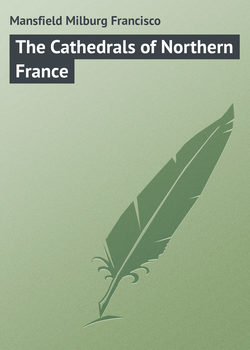Читать книгу The Cathedrals of Northern France - Mansfield Milburg Francisco - Страница 7
PART I
Transition Examples
IV
NOTRE DAME DE SOISSONS
ОглавлениеSoissons, the other primitive example, is at once a surprise and a disappointment. From the railway, on entering the town, one is highly impressed with the grouping of a sky-piercing, twin-spired structure of ample and symmetrical proportions; and at some distance therefrom is seen another building, possibly enough of less importance. Curiously, it is the cathedral which is the less imposing, and, until one is well up with the beautifully formed spires, he hardly realizes that they represent all that is left of the majestic Abbey of St. Jean des Vignes, where Becket spent nine long years. It is a mere bit of stage scenery, with height and breadth, but no thickness. It is a pity that such a charming structure as this noble building must once have been is now left to crumble. The magnificent rose window, or rather the circular opening which it once occupied, is now but a mere orifice, of great proportions, but destitute of glazing. The entire confines of the building, which crowns a slight eminence at the entrance of the town, are now given over to the use of the military authorities.
A little to the right lies the one-time cathedral of Notre Dame, Soissons being another of the ci-devant bishoprics suppressed after the Revolution by the redistribution which gave but one diocese to a Department. Though not unpleasing, its façade is marred by its lack of symmetry, while the tower, which rises on the right 215 feet, is not sufficiently striking to redeem what otherwise is an ordinary enough ensemble. The tower to the left was never raised above where it now ends, and the façade, lacking the charm which the edifice might otherwise have had, were the towers as complete and well proportioned as are those of a later date which grace the remains of the old abbey, will be for ever wanting until this completion be carried out.
Romanesque is plainly noticeable in mixture with the early Gothic. The three portals are not remarkable, or uniform, and are severely plain, and, though of a noticeable receding depth, are bare and unpeopled. A well-proportioned rose window, though not so large as many in the greater cathedrals, has graceful radiating spokes and good glass. This is flanked by two unpierced lancet-pointed window-frames which but accentuate the plainness of the entire façade. Above is an arcaded gallery which was intended to cross the entire front, but which now stops where the gable joins the northerly tower. Restoration has been carried on, not sparingly, but in good taste, with the result that, in spite of its newness at the present writing, it appears as a consistent and thoroughly conscientious piece of work, and not the mere patchwork that such repairs usually suggest.
The guide-books tell one that Soissons is famous for its trade in haricot beans, and incidentally for the beans themselves, and for the great number of sieges which it has undergone, the last being that conducted by the Germans, who took possession in October, 1870, after a bombardment of three days.
Fergusson makes the statement, which is well taken, that the Cathedral of Notre Dame de Soissons, while not in any sense meriting the term magnificent, presents, in its interior arrangements, at least, a most symmetrical and harmonious ensemble. A curious though not unpleasing effect is produced by the blackened pointing of the interior masonry, of piers, walls, and vaulting alike. An unusual feature is the circumambient aisles to the transepts and the suggestion that a trefoil apsidal termination was originally thought of, when the rebuilding was taken in hand in the twelfth century. The transept is so completed on the south side, which possesses also an ancient portal, and, with the two at Noyon so done, presents a feature which is as much a relief from the usual rectangle as are the rounded choirs of Continental churches a beauty in advance of the accepted English manner of treatment of this detail.
The choir rises loftily above the transepts and nave, and, while the general proportions are not such as to suggest undue narrowness, the effect is of much greater height than really exists. This, too, is apparent when viewing the abside itself.
The Chapel of the Rosary in the north transept is overtopped by an effective arrangement of perpendicular window-framing, supporting a beautiful rose window of the spoke variety. It is safe to say that, had the entire space provided been glazed, the effect of lighting would have been unique among the cathedrals of the world.
The only other decorative embellishments are some tapestries, a few well-preserved tombs, and an "Adoration" supposed to be by Rubens, which is perhaps more likely to be genuine, because of the situation of the church near unto Flanders, than many other examples whose claims have even less to support them.
